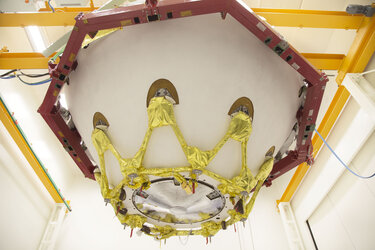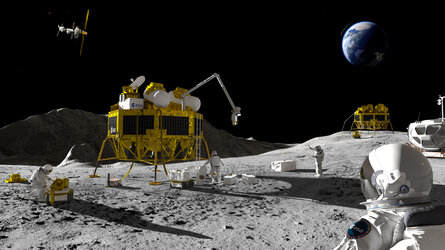Accept all cookies Accept only essential cookies See our Cookie Notice

About ESA
The European Space Agency (ESA) is Europe’s gateway to space. Its mission is to shape the development of Europe’s space capability and ensure that investment in space continues to deliver benefits to the citizens of Europe and the world.
Highlights
ESA - United space in Europe
This is ESA ESA facts Member States & Cooperating States Funding Director General Top management For Member State Delegations European vision European Space Policy ESA & EU Space Councils Responsibility & Sustainability Annual Report Calendar of meetings Corporate newsEstablishments & sites
ESA Headquarters ESA ESTEC ESA ESOC ESA ESRIN ESA EAC ESA ESAC Europe's Spaceport ESA ESEC ESA ECSAT Brussels Office Washington OfficeWorking with ESA
Business with ESA ESA Commercialisation Gateway Law at ESA Careers Cyber resilience at ESA IT at ESA Newsroom Partnerships Merchandising Licence Education Open Space Innovation Platform Integrity and Reporting Administrative Tribunal Health and SafetyMore about ESA
History ESA Historical Archives Exhibitions Publications Art & Culture ESA Merchandise Kids Diversity ESA Brand CentreLatest
Space in Member States
Find out more about space activities in our 23 Member States, and understand how ESA works together with their national agencies, institutions and organisations.
Science & Exploration
Exploring our Solar System and unlocking the secrets of the Universe
Go to topicAstronauts
Missions
Juice Euclid Webb Solar Orbiter BepiColombo Gaia ExoMars Cheops Exoplanet missions More missionsActivities
International Space Station Orion service module Gateway Concordia Caves & Pangaea BenefitsLatest
Space Safety
Protecting life and infrastructure on Earth and in orbit
Go to topicAsteroids
Asteroids and Planetary Defence Asteroid danger explained Flyeye telescope: asteroid detection Hera mission: asteroid deflection Near-Earth Object Coordination CentreSpace junk
About space debris Space debris by the numbers Space Environment Report In space refuelling, refurbishing and removingSafety from space
Clean Space ecodesign Zero Debris Technologies Space for Earth Supporting Sustainable DevelopmentLatest
Applications
Using space to benefit citizens and meet future challenges on Earth
Go to topicObserving the Earth
Observing the Earth Future EO Copernicus Meteorology Space for our climate Satellite missionsCommercialisation
ESA Commercialisation Gateway Open Space Innovation Platform Business Incubation ESA Space SolutionsLatest
Enabling & Support
Making space accessible and developing the technologies for the future
Go to topicBuilding missions
Space Engineering and Technology Test centre Laboratories Concurrent Design Facility Preparing for the future Shaping the Future Discovery and Preparation Advanced Concepts TeamSpace transportation
Space Transportation Ariane Vega Space Rider Future space transportation Boost! Europe's Spaceport Launches from Europe's Spaceport from 2012Latest

ExoMars rover joins Kazachok platform
Thank you for liking
You have already liked this page, you can only like it once!
The ExoMars Rosalind Franklin rover is seen here sitting on top of the Kazachok surface science platform in stowed configuration, rather similar to how it will journey to Mars in 2022.
The duo were mated in a dedicated clean room at Thales Alenia Space (TAS), Cannes, together forming the so-called ‘landing module’. The latest round of tests include electrical, power and data transfer checks between the two elements.
The landing module will later be integrated inside the descent module for mass balancing checks, together with the carrier module that will transport the mission to Mars.
This is not the last time the two flight models will be mated. After completion of the tests in Cannes, the rover will return to the TAS cleanrooms in Turin, Italy, for further functional testing, before being shipped to the launch site in Baikonur.
In this image, the back right solar panel of the landing platform is seen partially deployed. The front of the rover is seen, with its iconic drill stowed in horizontal position. A first in Mars exploration, the drill will extract samples down to a maximum of two metres, where ancient biomarkers may still be preserved from the harsh radiation on the surface, and deliver them to the rover’s sophisticated laboratory for analysis.
The mission is targeting a September 2022 launch window, landing on Mars in June 2023. Its goal is to determine the geological history of the landing site at Oxia Planum, once thought to host an ancient ocean, and to determine if life could ever have existed on Mars.
The ExoMars programme is a joint endeavour between ESA and the Russian State Space Corporation, Roscosmos.
The integration activities at Cannes were carried out by Thales Alenia Space and Airbus Defence and Space teams.
-
CREDIT
Thales Alenia Space -
LICENCE
ESA Standard Licence

ExoMars rover joins Kazachok platform

ExoMars platform and rear jacket

ExoMars descent module

ExoMars modules integrated














 Germany
Germany
 Austria
Austria
 Belgium
Belgium
 Denmark
Denmark
 Spain
Spain
 Estonia
Estonia
 Finland
Finland
 France
France
 Greece
Greece
 Hungary
Hungary
 Ireland
Ireland
 Italy
Italy
 Luxembourg
Luxembourg
 Norway
Norway
 The Netherlands
The Netherlands
 Poland
Poland
 Portugal
Portugal
 Czechia
Czechia
 Romania
Romania
 United Kingdom
United Kingdom
 Slovenia
Slovenia
 Sweden
Sweden
 Switzerland
Switzerland

























